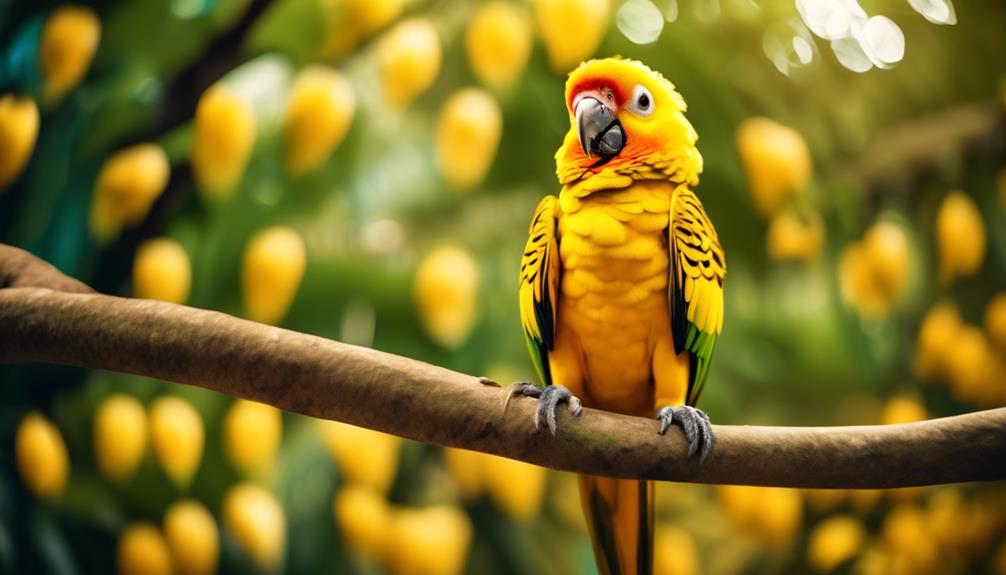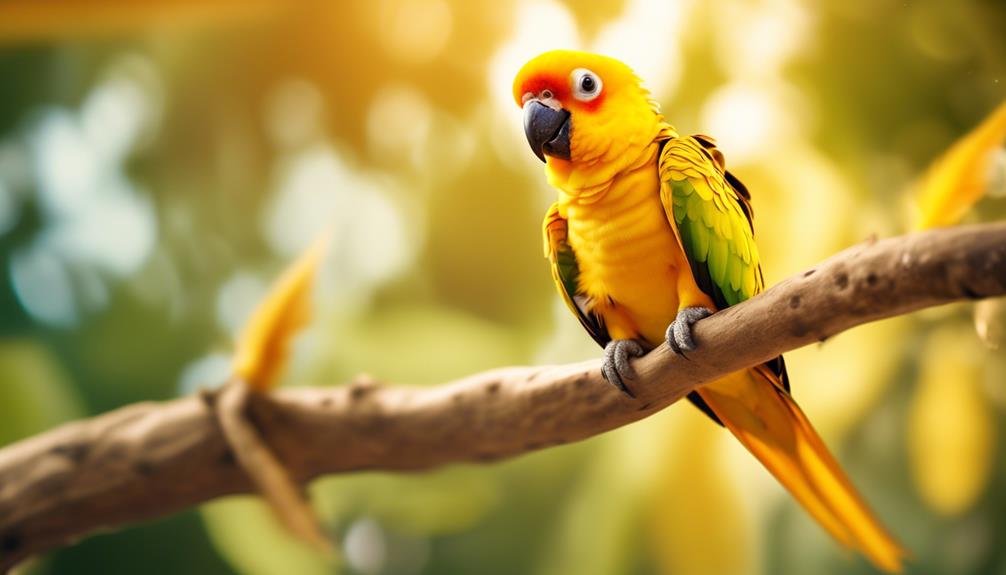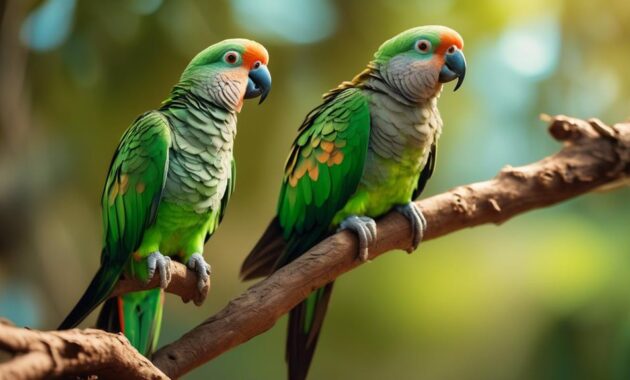
Ready to immerse yourself in the vibrant world of the Golden Conure? Prepare to be captivated by the beauty, intelligence, and charm of this rare parrot species. From its striking appearance to its unique abilities, there is so much to discover about these fascinating birds.
But their story goes beyond their vibrant feathers and captivating personality. Join us as we uncover the challenges they face in their native habitat and explore the measures being taken to protect them.
Get ready to unlock the secrets of the Golden Conure’s world, and be prepared to be amazed.
Key Takeaways
- Golden Conures are a relatively healthy species of parrot that require social interaction and ample space for their well-being.
- They are native to a small region in northern Brazil and their numbers have declined due to deforestation, trapping, and predators.
- Golden Conures have a striking appearance with a large beak and wide tail, and they can be kept in an aviary or large cage.
- They are vocal birds that can mimic human speech and enjoy music, and they are entirely colored in a bright yellow with green wing tips.
Size and Lifespan of Golden Conures

Golden Conures are a medium-sized parrot species with an average lifespan of 30 years. They measure approximately 13 inches in size. These vibrant birds are relatively healthy and require social interaction and ample space for their well-being.
Golden Conures are often compared to Hyacinth Macaws and Major Mitchell’s Cockatoos. They’re native to a small region in northern Brazil, inhabiting an area between the Tocantins, Tapajos, and Xingu rivers. Due to rapid deforestation, illegal trapping, and predators, their numbers have declined, leading to their high protection status.
Golden Conures have a striking appearance with a large, macaw-like beak and a wide tail. They require a lot of space and can be kept in an aviary or a large cage.
Health and Well-being of Golden Conures

To ensure the health and well-being of these vibrant birds, it’s important to consider the care and maintenance required for Golden Conures. Here are some key factors to keep in mind:
- Diet: Provide a balanced diet consisting of a seed mix for larger parrots, along with protein-rich foods like cooked corn, beans, and pulses. Don’t forget to include a variety of fruits and vegetables.
- Hygiene: Regular baths and showers are essential for their health. Ensure they have access to clean water for drinking and bathing.
- Social Interaction: Golden Conures thrive on social interaction. Spend time with them, engage in play, and provide mental stimulation through toys and puzzles.
- Veterinary Care: Regular check-ups with an avian veterinarian are crucial to monitor their overall health and detect any potential issues early on.
Golden Conures: A Type of Parrot

As a type of parrot, Golden Conures captivate with their vibrant colors and charming personalities. These beautiful birds are native to a small region in northern Brazil and are often compared to Hyacinth Macaws and Major Mitchell’s Cockatoos.
Golden Conures have a striking appearance, with a large beak and a wide tail. They require ample space and can be kept in an aviary or a large cage. Known for their vocal abilities, Golden Conures can mimic human speech and common sounds. They’re entirely colored in a bright, rich yellow, with tropical green wing tips for contrast.
When it comes to care, they should be fed a seed mix for larger parrots and protein-rich foods. Golden Conures are known for their silly and affectionate behavior, making them great companion parrots.
Comparing Golden Conures to Other Breeds

When comparing Golden Conures to other breeds, you’ll notice their vibrant colors and charming personalities stand out among the parrot community. Here are some key differences that set them apart:
- Size, Lifespan, and Health: Golden Conures are approximately 13 inches in size and have an average lifespan of 30 years. They’re relatively healthy and require social interaction and ample space for their well-being.
- Species, Comparable Breeds, and Native Region: Golden Conures are a type of parrot and are often compared to Hyacinth Macaws and Major Mitchell’s Cockatoos. They’re native to a small region in northern Brazil, inhabiting an area between the Tocantins, Tapajos, and Xingu rivers.
- Appearance and Habitat: Golden Conures have a striking and robust appearance, with a large, macaw-like beak and a wide tail. They require a lot of space and can be kept in an aviary or a large cage. They’re often considered part of the family and given freedom in the house.
- Speech, Sounds, and Colors: Golden Conures are vocal and can mimic human speech, as well as mimic common sounds like kisses, beeps, and barks. They’re entirely colored in a bright, rich yellow, with tropical green wing tips for contrast.
Native Region of Golden Conures

Golden Conures originate from a small region in northern Brazil, nestled between the Tocantins, Tapajos, and Xingu rivers. This region provides the perfect habitat for these beautiful birds, with its lush rainforests and abundant food sources.
Unfortunately, the native region of Golden Conures is under threat due to deforestation, illegal trapping, and the presence of predators. As a result, their numbers have declined significantly, and they’re now classified as a highly protected species.
Efforts are being made to conserve their natural habitat and protect them from further harm. It’s important for us to appreciate and understand the importance of preserving the native region of Golden Conures to ensure the survival of these vibrant and charming birds.
Striking Appearance of Golden Conures

With their vibrant yellow feathers and bold beak, Golden Conures make a striking impression wherever they go. Here are four features that contribute to their unique appearance:
- Robust build: Golden Conures have a solid and sturdy physique, with a large, macaw-like beak and a wide tail. Their strong build adds to their overall presence and charm.
- Bright coloration: These conures are entirely colored in a bright, rich yellow, which exudes energy and vibrancy. Their tropical green wing tips provide a beautiful contrast, enhancing their eye-catching appearance.
- Expressive eyes: Their round, dark eyes are full of curiosity and intelligence. They seem to sparkle with a mischievous glint, adding to their charismatic appeal.
- Graceful flight: When in flight, Golden Conures display grace and elegance. Their yellow feathers shine in the sunlight, creating a mesmerizing sight that captures the attention of anyone lucky enough to witness it.
Suitable Habitat for Golden Conures

To ensure the well-being of Golden Conures, it is important to provide them with a suitable habitat. These vibrant parrots require ample space to thrive and can be kept in an aviary or a large cage. However, they are often considered part of the family and given freedom in the house.
| Habitat Requirements | |
|---|---|
| Space | Golden Conures need plenty of space to move around and exercise their wings. |
| Perches | Provide sturdy perches of different sizes and textures to keep their feet healthy. |
| Toys and Enrichment | Keep them mentally stimulated with toys, puzzles, and foraging opportunities. |
| Temperature and Humidity | Maintain a temperature range of 70-80°F (21-27°C) with humidity levels between 50-60%. |
Creating a suitable habitat for Golden Conures involves meeting their physical and mental needs. By providing them with the right environment, you can ensure their well-being and happiness.
Vocal Abilities and Colorful Features

Their vibrant plumage and melodic calls make Golden Conures a true spectacle to behold. Here are some key features that make them stand out:
- Vocal Abilities:
- They’ve the ability to mimic human speech, creating a unique bond with their owners.
- Golden Conures can also mimic common sounds like kisses, beeps, and even barks, adding a playful touch to their repertoire.
- Colorful Features:
- These parrots are entirely colored in a bright, rich yellow, making them a vibrant sight to see.
- Their tropical green wing tips provide a striking contrast, adding to their overall beauty.
With their impressive vocal talents and stunning colors, Golden Conures bring joy and liveliness to any environment they inhabit. Whether they’re entertaining you with their mimicry or simply brightening up your day with their vibrant appearance, these charming parrots are truly a sight to behold.
Care and Feeding of Golden Conures

Now let’s focus on the important aspects of caring for and feeding Golden Conures.
When it comes to their care, providing them with a nutritious diet is crucial. Golden Conures should be fed a seed mix specifically designed for larger parrots, along with protein-rich foods like cooked corn, beans, and pulses. Additionally, fruits and vegetables should be included in their diet to ensure a well-rounded nutrition.
Regular baths and showers are also important for their overall health and hygiene.
In terms of their personality, Golden Conures are known for their silly and affectionate behavior, which makes them great companion parrots.
Personality Traits of Golden Conures

Golden Conures exhibit a unique and captivating combination of personality traits. Here are four key traits that paint a picture of their charming character:
- Playfulness: Golden Conures are known for their playful nature. They enjoy interacting with toys, performing tricks, and engaging in games with their owners. Their cheerful demeanor and love for fun make them delightful companions.
- Affection: These parrots have a strong bond with their human caregivers. They crave attention and affection, often seeking physical contact through cuddling and nuzzling. Their loving nature makes them endearing pets.
- Curiosity: Golden Conures are highly curious birds. They love exploring their surroundings and investigating new objects. Their inquisitive nature keeps them entertained and stimulated.
- Vocalization: These birds aren’t only colorful but also quite vocal. They have a wide range of vocalizations, from mimicking human speech to imitating various sounds. Their ability to communicate adds to their charm and entertainment value.
Fun Facts About Golden Conures

After exploring the charming personality traits of Golden Conures, let’s dive into some fascinating facts about these vibrant parrots.
Did you know that Golden Conures have a unique scientific name, Guaruba? It’s true! These parrots are also known for their rescue from shelters, as they’re highly sought after by bird enthusiasts.
Golden Conures have earned a reputation as one of the most charming and silly parrots in the world. They’re vocal and can mimic human speech, as well as mimic common sounds like kisses, beeps, and barks.
These vibrant parrots are entirely colored in a bright, rich yellow, with tropical green wing tips for contrast. They aren’t only beautiful but also make great companion parrots, thanks to their silly and affectionate behavior.
Frequently Asked Questions
What Is the Average Weight of a Golden Conure?
The average weight of a Golden Conure is around 400 grams. They are relatively lightweight for their size, which is approximately 13 inches. These charming birds are known for their vibrant appearance and playful personalities.
How Many Eggs Does a Golden Conure Typically Lay in a Clutch?
A Golden Conure typically lays 2 to 4 eggs in a clutch. They are known for their vibrant appearance and charming personality, making them a delightful addition to any family.
Are Golden Conures Prone to Any Specific Health Issues?
Golden Conures are relatively healthy, but like any living creature, they can be prone to specific health issues. Regular vet check-ups and a balanced diet can help ensure their well-being.
Can Golden Conures Be Trained to Perform Specific Tricks?
Yes, you can train Golden Conures to perform specific tricks. They are receptive to music, enjoy dancing, and mimic human speech. With patience and positive reinforcement, they can learn a variety of entertaining tricks.
Are Golden Conures Endangered in Their Native Region?
Yes, Golden Conures are endangered in their native region due to deforestation, illegal trapping, and predators. Their declining numbers have led to their high protection status.
What Makes the Golden Conure’s World Vibrant and Charming, Similar to the Pale Headed Rosella?
The vibrant and charming Golden Conure’s world is similar to the Pale Headed Rosella in many ways. Both birds are known for their stunning plumage and cheerful demeanor, bringing color and life to their natural habitats. Whether in the wild or in captivity, these charming pale headed rosellas captivate observers with their beauty and exuberance.
Conclusion
So there you have it, a glimpse into the vibrant world of the Golden Conure.
These rare and charming parrots may face challenges, but their beauty, intelligence, and affectionate nature make them truly special.
From their bright yellow feathers to their ability to mimic speech, Golden Conures are sure to bring endless joy and companionship.
With proper care and attention, these magnificent birds can thrive and continue to enchant bird lovers around the world.




